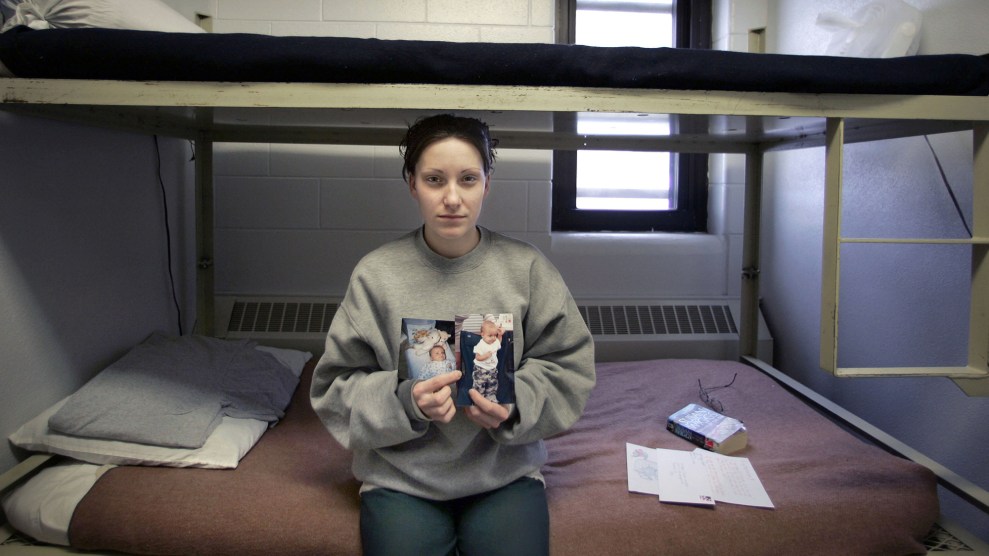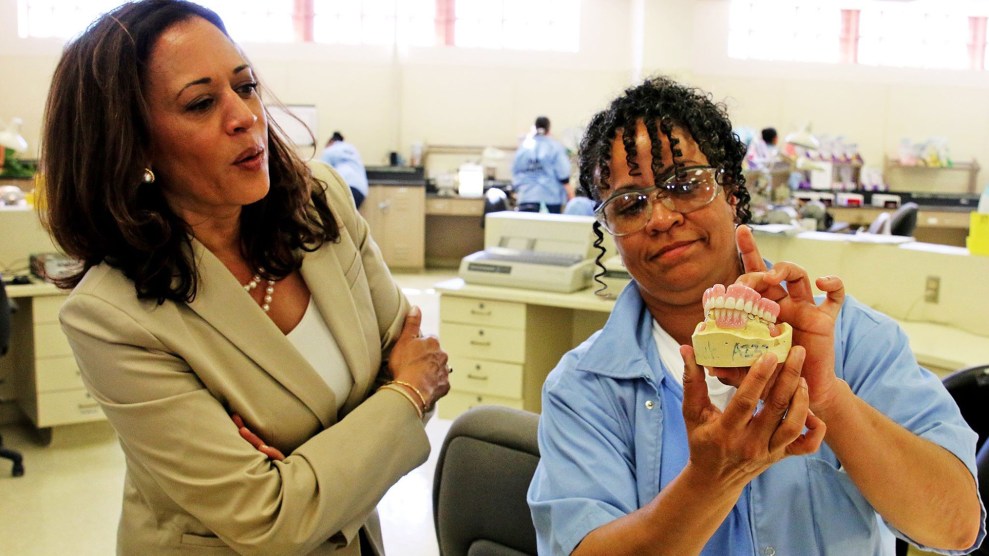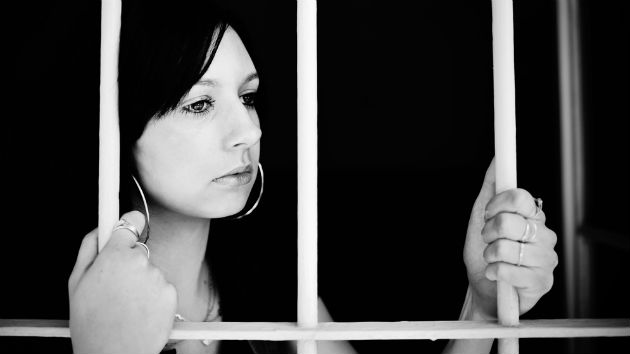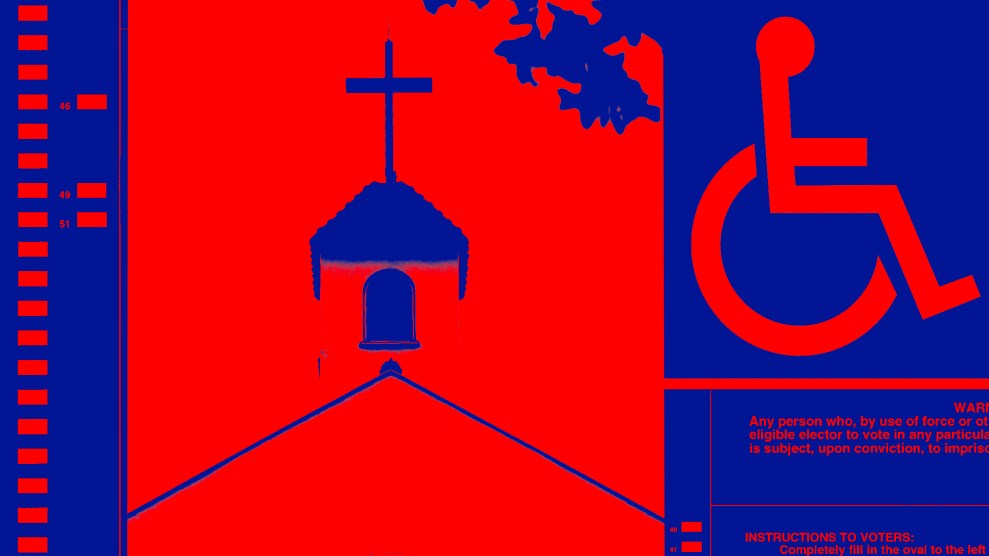
Samantha Luther was shackled during the 2004 birth of her son Rhylee at a Wisconsin prison.Sharon Cekada/AP
A few weeks ago, a group of Democratic senators introduced the Dignity for Incarcerated Women Act, which would compel federal prison officials to be more attentive to the unique needs of female inmates when it comes to things like parenting, visitation, and access to health care. Among the bill’s provisions is a federal ban on restraints for pregnant prisoners—who in many states can still be forced to go through labor and delivery while shackled to a bed. As a medical resident, Dr. Carolyn Sufrin—who is now a medical anthropologist and an OB-GYN at Johns Hopkins School of Medicine—delivered the baby of one such prisoner and was appalled by the inhumanity of it. Her recent book, Jailcare: Finding The Safety Net for Women Behind Bars, explores the experiences of pregnant women who gave birth while incarcerated. I reached out to Sufrin to learn more about prison births, the problems of impoverished pregnant women, and how to reform a male-dominated justice system that often fails to attend to women’s concerns.
Mother Jones: What got you interested in pregnancy and childbirth in jail?
Carolyn Sufrin: When I was a first-year resident in OB-GYN, doing my training in Pennsylvania, I was on call one night and I delivered the baby of a woman who was shackled to the bed. I was just so taken aback and so disturbed by it—not as much as she was. It just opened up this whole Pandora’s box. When I got to San Francisco, I sought out the opportunity to do research and to work in the San Francisco jail. I stared doing a volunteer clinic there maybe twice a month. I knew there was something going on when I heard from patients that they hated jail and also that this was the only place where they got care.
MJ: How frequent are prison births?
CS: We have no idea. That is actually the subject of a research project that I am doing right now. The only data we have comes from a 1997 survey by the American Correctional Association of about 47 state prison systems, and that reported 1,400 births. But that was a long time ago. People just really don’t think about women who are incarcerated. We have zero systematic information on how many incarcerated women have miscarriages, abortions, stillbirths—basic vital statistics.
MJ: In Orange Is The New Black, the character Daya is pregnant for the first three seasons and ultimately gives birth. How accurate was that depiction?
CS: The isolation and separation from one’s baby that they depicted is very accurate. But the experiences of these women are highly variable and depend on what state they are in, whether they are in a prison or a jail, and what the local policies are. At the San Francisco jail, when a pregnant woman starts to have symptoms of labor, she reports it to a guard. Usually the woman would first be evaluated by a nurse, who would determine whether or not she needs to be a transported to a hospital. She would then be taken from the jail in some sort of vehicle, and this is where things start to vary by state: There are only 22 states [now at least 23] that prohibit the shackling of women in childbirth, and even some of those states allow it during transport.
MJ: Is there any rationale for shackling these women?
CS: From a medical perspective, no. There are very clear medical risks involved, which have to do with the need of women to move about freely, both for pain control but also if there’s an emergency. Then there is the common-sense perspective: What is the risk that a woman is a threat to society or a flight risk in between painful contractions? But from the custody side, they see everything as a potential risk that she is going to run off or a risk to public safety. But that’s all laced with the punitive aspect of chains as well—there’s that subtle, “Well, look what she did to deserve this.” It speaks to the way the system is set up to view incarcerated people as less than human, and to apply the same logic to a pregnant female prisoner that they might to a male prisoner.
MJ: Does California allow shackling?
CS: California does not. A prisoner would have a guard outside of her hospital room. She would not generally be allowed to have visitors—maybe during one hour when they designate visiting hours for incarcerated patients. But since childbirth is not planned, it is unlikely that would tend to coincide with visiting hours. So she would give birth alone with the medical staff. In some places they treat her as any other patient and allow a two-day recovery after a vaginal delivery or three to four after a cesarean delivery, but in some places they rush them out of the hospital to get them back to the jail or prison, because having that guard outside her room is extra overtime and an expense for the facility. It also varies in terms of whether she can [keep] the baby in her room. In many other places she has to be escorted to the nursery to see her baby, and she might have to do that while in chains and shackled, and she might not be given the opportunity to breastfeed, even in the hospital. And then she has to go back to the jail or prison having just given birth, and not with her baby.
MJ: Doesn’t research say breastfeeding is very important for newborns?
CS: There are so many benefits for the baby and for the mother. For the infant, lower risk of ear infections in the first year of life; it boosts their immunity; it’s helpful for reducing the risk of asthma in the long term. It also reduces the risk of other chronic diseases in both infant and mother. There are also a lot of psychological benefits to promoting infant bonding. It is generally not available to incarcerated women because people don’t really think about it. It speaks to the fact that the default is to presume that every prisoner is male.
I should say that some prisons and jails, including San Francisco, do have policies and protocols to allow women to breastfeed and to provide breast milk. I’ve heard people give all sorts of reasons about why it can’t be done: The logistics are too complicated. What if you give the wrong milk to the wrong baby? What if it’s contaminated or not stored correctly? Then you also get some things that really speak to the way that some people see prisoners in a very judgmental and harsh light. They say, “What if they poison the breast milk?” Or “What if they use the pump to make a weapon?” For some people, the default is to presume that incarcerated people are inherently dangerous.
MJ: How many babies have you delivered for prisoners?
CS: Over the seven years I was at the San Francisco County Hospital, probably 10.
MJ: To what extent were these experiences traumatic for the women?
CS: For some, they felt all alone and isolated. For others, we were able to create a semblance of normal motherhood. Their jail uniform was balled up in a corner—they were wearing a patient gown. When you walked into the room, you saw them as any other patient. The San Francisco Hospital labor and delivery unit really went to great lengths to treat these patients with dignity and respect. Some of them I think felt that, but not everyone.
MJ: Give me an example of when things went wrong.
CS: I had a patient who in the book I call Kima. Her baby was supposed to go under the care of her sister until Kima got out of jail. In the course of filling out the paperwork, Child Protective Services learned that the sister had an open CPS case. So they said, sorry, your baby can’t go with her—we need to find some alternative. So while Kima was working to find some other family member and CPS was working to find a foster home, the CPS worker assigned to this case decided to put a “police hold” on the baby. That meant the baby could no longer be in her room and she could no longer visit her baby except by going to the nursery with handcuffs on. That was an extremely arbitrary decision.
The reason CPS would put a police hold on a baby is if they are worried about the baby’s safety. But that was completely unnecessary in Kima’s case. She had an armed guard outside of her room, she wasn’t going to run out with her baby. Being unable to be with her baby for those precious 48 hours after birth caused her tremendous anguish. I can still hear her wailing when she was told that they were taking the baby to the nursery.
MJ: Did you ever learn more about Kima and her child?
CS: She had been in jail more than 80 times in her adult life. Like most incarcerated women in the United States, most of Kima’s arrests were for nonviolent offenses. For this particular pregnancy, they were for selling a small amount of drugs. The last time she was arrested in pregnancy and then stayed on to deliver, she was arrested for shoplifting a bar of Dove soap from a local drugstore. They are generally small crimes where incarceration isn’t necessarily the best answer—especially for pregnant women.
MJ: What ultimately happened to Kima and her baby?
CS: They baby initially had to go into foster care. Kima got released about two weeks after birth. The plan was for her to go to a drug treatment program designed for mothers and babies, but the program didn’t work out for Kima. She has been in and out of jail many times since. The last that I spoke to her, which was when the baby was almost three and being raised by a cousin on the Peninsula, Kima didn’t really see the baby very much. Jail was sometimes the main place where these women visited with their children because their lives on the streets were so precarious. They did not have stable housing, they struggled with addiction and poverty. But when they were in jail, they had people helping them connect with their children.
MJ: One woman from your book actually gets herself arrested so she can get services. Is that common?
CS: It’s not the norm, but it does happen. The woman, whom I call Evelyn, told me that at one point in her pregnancy she turned herself in. She had an outstanding warrant for a parole violation. “Everyone says I got arrested,” she told me, “but I got rescued. I was so sick, I didn’t want to get high no more. I just wanted to be in jail where I could eat, I could sleep, and where I was going to get some type of care.” She felt like had nowhere else to turn.
MJ: So was the quality of care in jail better than what she could have gotten on her own?
CS: The prenatal care available in the San Francisco jail was pretty equivalent to the care she would have gotten in the community. But that is not at all universal. There are many cases of pregnant women who are completely neglected in jail and prison—where complaints of vaginal care and bleeding are neglected, and people deliver their babies in a jail cell or have stillbirths.
MJ: Do you think it makes sense on some level for a women like Evelyn, pregnant and with a drug problem, to submit to incarceration?
CS: That is certainly a logic that has been inculcated a little bit, but jails and prisons are places of punishment. They are designed to strip people of their autonomy. So I think it speaks to the deficiency of mental health care and drug care services in the community that people might feel that way. If the first person they see when walking into one of these community clinics is an armed guard, that can make them feel alienated and not [likely to seek care].
MJ: So what’s the solution?
CS: A really important place to start is thinking about alternatives to incarceration. You can have whatever appropriate surveillance they might need from the criminal justice system, but give them an opportunity to access community health care and prepare for being a mother in a realistic environment. San Francisco has invested in some of these programs—houses you and I may have even walked by. One of them, in the Mission, is staffed by people from local agencies. They have parenting classes, drug treatment if they need it. Women can go to their court appearances, but they have a chance to develop their pregnancies and give birth not in an institution that is designed to punish, confine, and separate them.
MJ: What became of Evelyn?
CS: The child is now four and a half and doing very well, but unfortunately Evelyn is still trapped in the criminal justice system.
MJ: What do you hope that readers will take away from your book?
CS: That talking about mass incarceration is always very messy. For some people, jail has become part of their safety net. That’s not to say that jail is good, and it’s not to say we need to make jails harsher so people feel more uncomfortable and more punished. Not at all. It is just to say that this is the system we’ve created and need to reform on multiple levels.
















